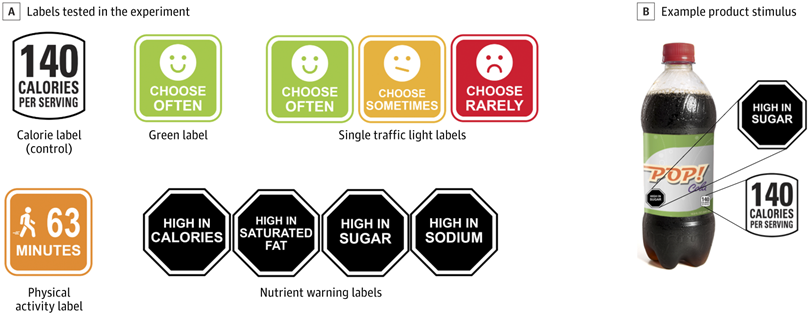
One Agency’s Maps Are Known For Documenting Redlining
But Many Other Factors Played a Role in Denying Loans, LDI Fellow Says
Population Health
Blog Post

“A chance like this only comes every so often,” says LDI Senior Fellow Christina Roberto, PhD when asked about the history and importance of the FDA’s recent efforts to implement front-of-package food labels.
The FDA’s first food labels—specifically, back-of-package labels—arrived on products in 1994, listing the amount of fat, cholesterol, sodium, carbohydrates, and protein, as well as some vitamins. And the next update came in 2016, propelled by new scientific information emphasizing the link between diet and chronic disease. Those efforts focused on back-of-package labeling.
In Fall of 2022, the Biden Administration released its National Strategy on Hunger, Nutrition, and Health, proposing the first national front-of-package label system. In 2023, the FDA announced plans to conduct a study on front-of-package labeling to inform future rule-making on the topic. Also, in December 2023, the “TRUTH [transparency, readability, understandability, truth, and helpfulness] in Labeling Act” was introduced in the U.S. Senate and House of Representatives that would establish mandatory, nutrient-specific, and interpretative front-of-package labels for foods and beverages. Ideally these efforts will empower consumers to make better choices and encourage industry to create healthier food.
Poor diets remain a leading cause of death in the United States, and Roberto sees front-of-package labels as “one of the few tools we have to hold industry accountable and to make nutrition information transparent and easily accessible to everyone.”
Along with LDI Senior Fellows Laura A. Gibson, Alisa J. Stephens-Shields, and colleagues, Roberto recently examined how to devise understandable front-of-package labels that are easy for consumers to understand and use. In “Effects of 4 Interpretive Front-of-Package Labeling Systems on Hypothetical Beverage and Snack Selections,” they describe testing four front-of-package food labeling systems to measure their effect on consumer choice and found food labels with colored images like the ones below were clearer to participants and led them to select lower-calorie beverages and snacks than calorie labels alone, which is the type of label the food industry currently uses.

To learn more, we talked with Roberto about how front-of-package food labels could improve equity and industry transparency, and how the window to change our system is rapidly closing.
Roberto: Scientific research has shown that well-designed front-of-package labels influence behavior. They don’t produce huge effects but they do improve the food choices people make, provide them information that they have the right to know, and help to hold industry accountable to what’s in our food supply. Our packaged foods already have the nutrition facts label (i.e., back-of-package food labels), but these labels are dense and number-laden. They contain lots of percentages that we know a lot of people don’t look at or have trouble understanding. They can be quite confusing. Purely from a consumer’s right to know, it makes a lot of sense to do clear front-of-package food labeling, and we have a sufficient body of evidence that they can help people make healthier purchases.
Roberto: Our research has shown that simple labels are the most effective. They avoid numbers. They have some sort of icon or picture that not only captures consumer attention, but also helps them process the information on the package.
This specific point is key and being fought over very intensely right now among public health experts and industry. Most public health scientists and community groups really want these labels to just focus on the nutrients of concern like added sugar, saturated fat, and sodium. On the other hand, industry wants to include positive nutrients like protein and fiber, which concerns us because people don’t necessarily need more protein—as it’s not something we’re deficient in—and it can lead to consumer confusion. For example, unhealthy foods that display these positive nutrients could really confuse consumers. And so it’s really important that those positive nutrients are not on the package. The industry highlights those on their own and I don’t think the FDA’s mandated government system should highlight that. So that’s a very contentious issue right now.
Finally, others have done a nice job at demonstrating how our new [front-of-package] labels are well understood regardless of income and education. The whole reason we did this particular study was to see if education moderated label effects, and we didn’t see that. There tends to be an assumption that lower income people are not going to use these labels. But the whole point is we’re designing them in a way that anyone can act on them. And there will of course be high income people that don’t care or act on them. There’ll be low income people that don’t care or act on them. But people across every socioeconomic status or demographic who do care will have a label that they can act on if they want.
Roberto: Once we agree on the foods that are healthy and less healthy, front-of-package food labels make it a lot easier to create policies for programs like SNAP on what foods to incentivize consumers to purchase. Additionally, these labels can spur reformulation. If we have an established warning for added sugar on certain foods, like a sugar limit of sorts, a company will want to come under the sugar limit to not have that warning on their food product. So it can make them reformulate the food supply in potentially healthier ways. That being said, this will be very tricky because what we’re seeing in countries that are already using new front-of-package labels is that the industry is really ramping up non-nutritive, or non-sugar, sweeteners. And that’s potentially concerning. So we need to think about how to prevent that. Do those additives need to be labeled as well to alert consumers?
Roberto: The relationship between industry and government is a well-documented revolving door driven by financial interests and lobbying. Government is influenced by industry and, of course, vice versa. So I think that has really been the biggest barrier. But it’s also a super exciting time. We have already passed national calorie labeling, which was part of the Affordable Care Act, and now it does seem like we might get this front-of-package labeling system. So, in recent times, there has been some great progress on transparent food labeling systems. The fight right now is not so much about whether to label or not, it’s about what the label is going to look like. My concern is that we’re going to lock in a really weak, ineffective labeling system that we’re not going to be able to change for many years to come.
Labeling can be a polarizing issue. Some people think, ‘well labels just help wealthy people.’ Depending on the label design, that could be true although we actually have data that shows it’s not necessarily the case. But the industry loves that friction. For instance, now public health groups are fighting with each other. It’s very important to me that we keep the eye on the prize here, which is industry’s accountability of what’s in our food supply, which affects everyone. About 95% of the country has an unhealthy diet and we’re getting pitted against each other. We all have to work together to keep industry accountable.
Roberto: The bottom line of this study is that an effective front-of-package label will need to have easy-to-understand design elements such as a warning label. Furthermore, while there is sometimes concern that these front-of-package labels are going to promote weight stigma, that they’re going to be shaming, or they’re going to be distressing to folks, we actually found they did not increase feelings of weight stigma—which is something we really want to avoid. So that was very encouraging. And that’s something that is important for people to be thinking about and testing when they design these labels.
The study, “Effects of 4 Interpretive Front-of-Package Labeling Systems on Hypothetical Beverage and Snack Selections,” was published on September 13, 2023 in JAMA Network Open. Authors include Anna H. Grummon, Laura A. Gibson, Aviva A. Musicus, Alisa J. Stephens-Shields, Sophia V. Hua, and Christina A. Roberto.



But Many Other Factors Played a Role in Denying Loans, LDI Fellow Says

Offit and Buttenheim Criticize HHS Placebo Trial Mandate as Unethical, Misleading, and a Threat to Vaccine Confidence

A Penn LDI Virtual Seminar Explores the Latest Trends in Anchor Institution Operations

Neighborhood Perceptions May Also Affect PTSD and Depression Recovery After Serious Injury

A Penn LDI and Opportunity for Health Lab Virtual Seminar Explores Economic Assistance Programs

Testimony: Delivered to Philadelphia City Council